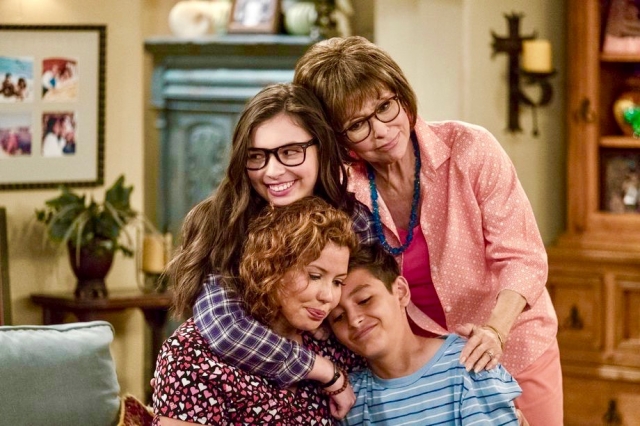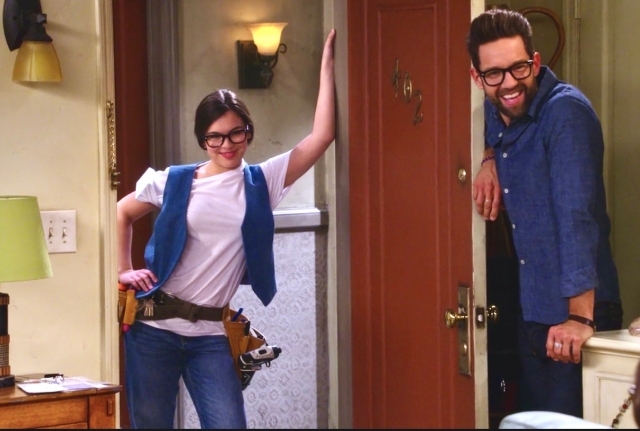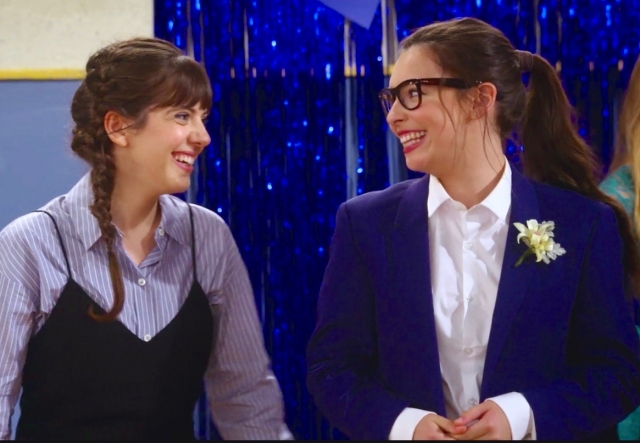One Day at a Time leads with its heart first. That was true in the popular Netflix sitcom’s first season, and that remains true throughout the second.
If you still haven’t seen it (or need a refresher), Netflix’s One Day at a Time is an modernized version of Norman Lear’s 1975 hit show about a single mother raising her two children, except in the new iteration the family is Cuban-American dealing with an updated set of social problems. The mother, Penelope (Justina Machado), known as Lupita to her family, is an Army veteran who is living with anxiety and depression stemming in part from her time in the service. The eldest daughter, Elena (Isabella Gomez), is a teen whose coming out story was the heartbeat of the first season. Penelope’s son, Alex (Marcel Ruiz), lovingly referred to as “Papito,” can charm any room. EGOT winner and living legend Rita Moreno stars as Penelope’s mother and the children’s grandmother, Lydia, also known as Abuelita, who lives with the family and takes care of the household. If you’ve watched the original before, yes there is a still a landlord named Schneider who hangs out around the apartment, but the new version casts him as younger and much more empathetic than the original.

So, let’s get back to its heart. One Day at a Time is the most generous, compassionate, loving family sitcom on television. That type of description often means a show is leaning toward the saccharine, but instead, One Day at a Time veers towards genuine. It’s not afraid to have frank, sometimes dark discussions — there’s perhaps no better case for this than the season’s episode dedicated Penelope’s ongoing battle with depression, or Elena’s estranged relationship with her father, who has poorly handled her coming out. Not everything is picture perfect, or cleanly fixed by the end of the episode with a group hug. Nevertheless, this is a family that loves each other relentlessly. Warmth emanates from every line, every angle, every corner.
In addition to the undeniable chemistry between castmates, I think part of that warmth comes from the format of the show itself. One Day at a Time is shot as a traditional multi-cam sitcom, complete with a live studio audience and a supplemental laugh track. As any ’90s or ’00s kid who grew up sneaking Nick at Nite past their bedtime or having their after-school snack to syndicated classics will tell you, multi-cam sitcoms are comforting in their own right. Think of The Mary Tyler Moore Show, Golden Girls, or even Friends. Still, the genre fell out of style with the onset of mockumentary style comedies like The Office or Modern Family and more ambitious storytelling models like 30 Rock or black-ish.

In the current slate of trendy television, a laugh track can feel outdated or, if we are honest with ourselves, even a little bit corny. Over the course of its two seasons, One Day at a Time has put forth a compelling argument that a little corny doesn’t always have to be a bad thing — and if nothing else, it doesn’t have to be limiting. The show uses the intimacy and familiarity of the genre to their advantage, luring their audience into cutting edge and weighty conversations from the comfort of the Alvarez’s living room.
One of those conversations? The complexities of being Latinx in Donald Trump’s America. The President’s name is never mentioned directly, which is surprising given how strongly the effects of his presence are felt throughout the fist half of the new season. Instead of focusing on specific headlines or upcoming laws, One Day at a Time deftly and accurately explores the interpersonal; delving into what it takes to keep your Latinx family fortified in an environment that’s openly hostile towards people of color. Executive Producer and co-showrunner Gloria Calderon Kellett made note of the purposeful difference between the first and second seasons, telling Remezcla, “We try to be true about what’s going on with this family… there’s been a change since we premiered after the election. I could feel a shift, and other Latinos in the room were feeling it as well”.

The show also doesn’t shy away from ups and downs of being a young Latina lesbian. Elena Alvarez has become something of a teen idol for those of us at Autostraddle since her coming out storyline, and subsequent gayest Quinceañera ever, in the first season. The second season keeps developing her character, including having a new love interest, Syd, who uses they/them pronouns and becomes Elena’s girlfriend.
If there is anything cuter than watching Elena get help from her Abuelita in learning how to flirt or more triumphant than Elena and Syd’s gay nerdy teen love for each other, I haven’t seen it yet. I mean, they dress as Dr. Who and the Tardis for their local comic-con, come on! Syd’s pronoun choice is deeply important for non-binary gender representation, and is handled with the show’s trademark care and wit. Also, the already great gay jokes in the second season are bolder, more frequent, and gayer than ever before. A bit where the show pays homage to the costuming of the 1970s original Schneider character is played as Elena learning to be butch.
The show doesn’t loose track of the difficulties of gay adolescence. My first real ugly-cry of the season came from an episode where Elena confronts her father, Victor, who walked out of her quinceañera in the first season finale. Heather Hogan has talked about the ways that another gay teen, Fresh Off the Boat’s Nicole, has been healing and invigorating for her, because Nicole is a teenager in the late 1990s who is experiencing her gayness in a way that Heather was not able to at the same time period and age. I feel similarly about Elena. I was not out in high school, for a lot of reasons, but also because I didn’t have working model for what being a young queer Latina would even look like. Watching Elena has been healing, and I’m so excited for the Latinx teens out there right now who can point to her as a model that I didn’t have.

Speaking of heart-wrenching, Justina Machado and Rita Moreno bring their best work out to play in One Day at a Time’s second season. In Vanity Fair, Moreno credited Machado as being “the best acting partner” she’s ever had. Taking into account Moreno’s long and illustrious career, that’s the highest of compliments — and I couldn’t agree more. I’ve been watching Machado work for decades; she’s a rare and multilayered talent. It’s a tragedy that there are so few well developed Latina parts in Hollywood that she wasn’t afforded the opportunity to really show the full range of her ability onscreen until now. My second, though certainly not last, ugly cry of the season? Watching her pull back the curtains and take us into the depths of Penelope’s depression. It left me exposed and raw in front of my television. I still haven’t adequately found ways to express the feelings that her performance unearthed.
As a Puerto Rican, I’m pretty sure I was born loving Rita Moreno, so I’m an easy mark when comes to fawning over her on camera. That said, I am floored that at four years away from 90 years old, she is busy creating what is arguably the greatest role of her career this side of West Side Story. If Elena was the emotional centerpiece of season one, then season two definitely belongs to Abuelita, who keeps her entire family together with a diva fabulousness, quick wit, sexual innuendos, and an open heart. Mi Reina, my queen, I will love you forever.

The tight rope balance between light, though nonetheless sharp, comedy and genuinely moving drama is no easy feat. One Day at a Time hits the sweet spot.
Last year, I joked to a friend that One Day at a Time is the most feminist show on television, but this year I’m willing to make that claim seriously. They approach every issue on their docket with an intersectional lens, without ever losing the mother/daughter relationships and the intimacies between Latina women that are at its core. Their jokes find the delicate place between being specific to our community, the ways that we poke fun, but also the ways that we love, and still being catchy to a broader audience. They aren’t afraid to tackle race, or class, or gender, sexuality, ability, or aging with an ever-present grace and care. I would be hard pressed to find an expectation of mine that they haven’t not only reached, but passed with flying colors.
My only complaint is that I have to wait another year to spend the weekend with the Alvarezes again. That’s truly unfair.
So now, the fun part: In the interest of highlighting One Day at a Time’s intergenerational, Latina feminism, and their emphasis on the relationship between Latina mothers and daughters, I interviewed my own Mamí about her thoughts and feelings towards season two! It’s more spoiler heavy than this review, but if I can be a wee bit biased for a second — my mom is so wonderful. And she was so generous with her time to do this. You should definitely check it out on the next page!







